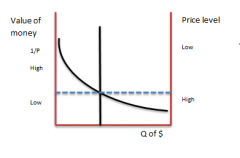![]()
![]()
![]()
Use LEFT and RIGHT arrow keys to navigate between flashcards;
Use UP and DOWN arrow keys to flip the card;
H to show hint;
A reads text to speech;
22 Cards in this Set
- Front
- Back
|
Classical theory of inflation |
interest rate is reflective of supply and demand for money |
|
|
when the price of something increases, the money used to buy it is |
less valuable |
|
|
Short term demand equals |
consumption |
|
|
long term demand equals |
investment |
|
|
Money supply, money demand, and Monetary equilibrium |

|
|
|
Quantity theory of money |
the quantity of money available determines the price level and that the growth rate in the quantity of money available determines the inflation rate |
|
|
nominal variables |
variables measured in monetary units
Money and prices |
|
|
real variables |
variables measured in physical units
output |
|
|
classical dichotomy |
the theoretical separation of nominal and real variables |
|
|
money neutrality |
the proposition that the change in money supply does not affect real variables |
|
|
velocity of money |
the rate at which money changes hands |
|
|
velocity of money equation |
V=(P*Y) / M |
|
|
p= |
price level (nominal GDP) |
|
|
y= |
quantity of output (real GDP) |
|
|
m= |
quantity of money |
|
|
quantity equation |
M*V=P*Y
relates the quantity of money, velocity of money, and the dollar value of the economy to the output of goods and services |
|
|
a rapid increase in the money supply leads to what in terms of inflation |
rapid increase in inflation |
|
|
inflation tax |
the revenue the government raises by creating money (value of money decreases) |
|
|
the fisher effect |
the one for one adjustment of the nominal interest rate to the inflation rate (nom IR - inflation rate = real IR) |
|
|
Shoeleather costs |
the resources wasted when inflation encourages people to reduce their money holdings (transportation) |
|
|
Menu costs |
costs of changing prices |
|
|
price confusion/misallocation of resources |
inflation causes dollars at different times to have different real values |

